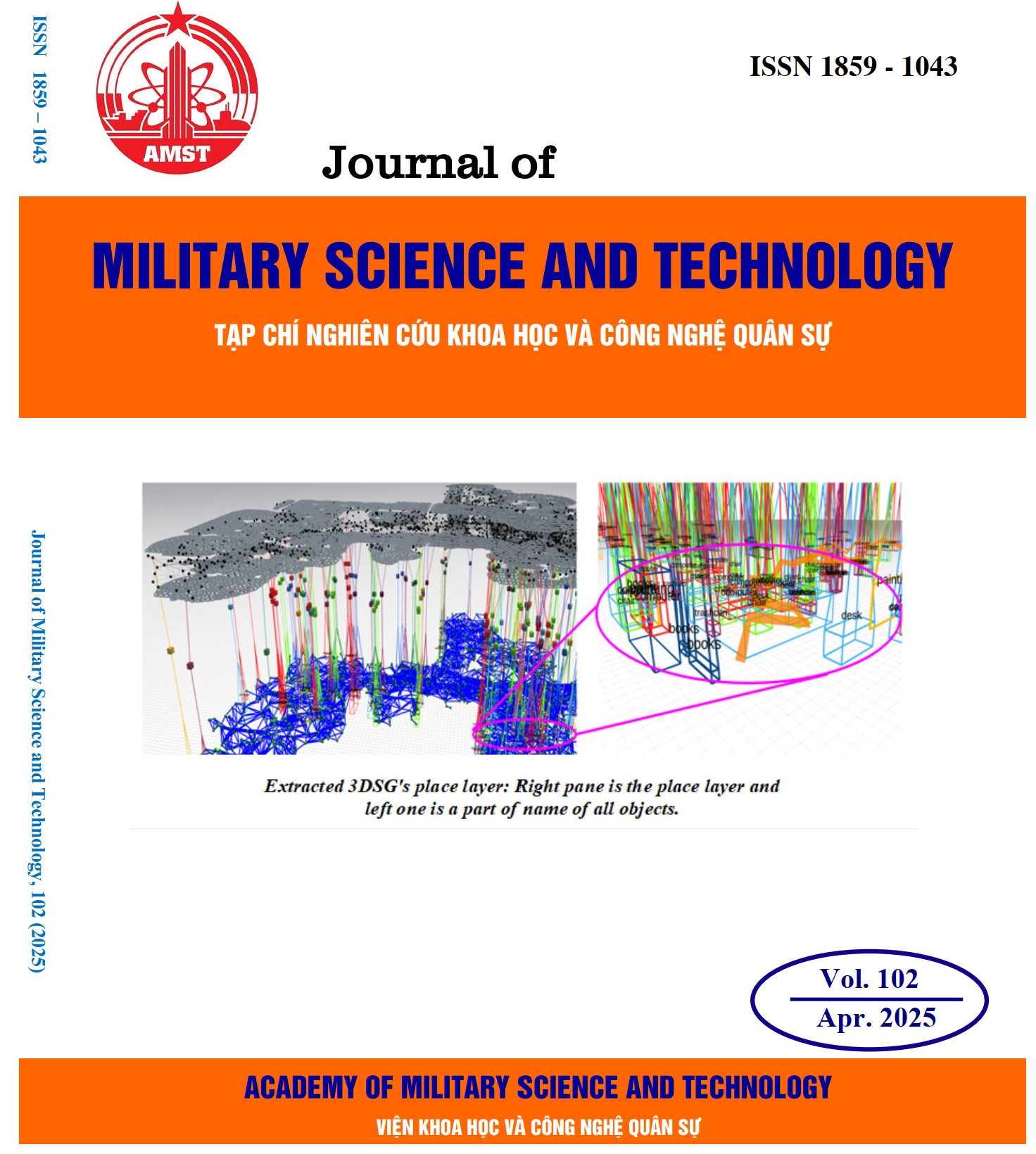Investigation of methylene blue adsorption on activated carbon surfaces: A combined approach of experimental study and molecular simulation
411 viewsDOI:
https://doi.org/10.54939/1859-1043.j.mst.102.2025.84-93Keywords:
Activated carbon; Methylene blue; Molecular simulation.Abstract
Wastewater containing methylene blue, commonly found in dyeing and textile effluents, poses significant environmental risks if left untreated. It can severely pollute water bodies, disrupt ecosystems, and threaten human health due to its toxicity. This study examined the ability of activated carbon to adsorb methylene blue from water. The activated carbon was pre-treated with various KOH ratios, achieving a maximum adsorption capacity of 619.92 mg/g. The adsorption process was analyzed using kinetic and isothermal models. Results showed that the process was best described by the pseudo-second-order kinetic model and the Langmuir isotherm model, both demonstrating high R² values. Molecular simulation methods were applied to explore the adsorption mechanism in greater detail. The findings indicated a multilayer adsorption mechanism dominated by electrostatic interactions, which facilitate strong bonding between the activated carbon surface and methylene blue molecules. Overall, the study highlights the potential of activated carbon as an effective solution for removing methylene blue from polluted water sources.
References
[1]. Oladoye P.O, Ajiboye T.O, Omotola E.O, and Oyewola O.J, "Methylene blue dye: Toxicity and potential elimination technology from wastewater", Results in Engineering, 16, p. 100678, (2022), https://doi.org/10.1016/j.rineng.2022.100678 DOI: https://doi.org/10.1016/j.rineng.2022.100678
[2]. Khan I, Saeed K, Zekker I, Zhang B, Hendi A.H, Ahmad A, Ahmad S, Zada N, Ahmad H, and Shah L.A, "Review on methylene blue: Its properties, uses, toxicity and photodegradation", Water, 14(2), p. 242, (2022), https://doi.org/10.3390/w14020242 DOI: https://doi.org/10.3390/w14020242
[3]. Moorthy A.K, Rathi B.G, Shukla S.P, Kumar K, and Bharti V.S, "Acute toxicity of textile dye Methylene blue on growth and metabolism of selected freshwater microalgae", Environmental Toxicology and Pharmacology, 82, p. 103552, (2021), https://doi.org/10.1016/j.etap.2020.103552 DOI: https://doi.org/10.1016/j.etap.2020.103552
[4]. Mashkoor F and Nasar A, "Magsorbents: Potential candidates in wastewater treatment technology–A review on the removal of methylene blue dye", Journal of magnetism magnetic materials, 500, p. 166408, (2020), https://doi.org/10.1016/j.jmmm.2020.166408 DOI: https://doi.org/10.1016/j.jmmm.2020.166408
[5]. Kuang Y, Zhang X, and Zhou S, "Adsorption of methylene blue in water onto activated carbon by surfactant modification", Water, 12(2), p. 587, (2020), https://doi.org/10.3390/w12020587 DOI: https://doi.org/10.3390/w12020587
[6]. Fito J, Abrham S, and Angassa K, "Adsorption of methylene blue from textile industrial wastewater onto activated carbon of Parthenium hysterophorus", International Journal of Environmental Research, 14, p. 501-511, (2020), https://doi.org/10.1007/s41742-020-00273-2 DOI: https://doi.org/10.1007/s41742-020-00273-2
[7]. El-Bery H.M, Saleh M, El-Gendy R.A, Saleh M.R, and Thabet S.M, "High adsorption capacity of phenol and methylene blue using activated carbon derived from lignocellulosic agriculture wastes", Scientific reports, 12(1), p. 5499, (2022), https://doi.org/10.1038/s41598-022-09475-4 DOI: https://doi.org/10.1038/s41598-022-09475-4
[8]. Jawad A.H, Abdulhameed A.S, Wilson L.D, Syed-Hassan S.S.A, ALOthman Z.A, and Khan M.R, "High surface area and mesoporous activated carbon from KOH-activated dragon fruit peels for methylene blue dye adsorption: optimization and mechanism study", Chinese Journal of Chemical Engineering, 32, p. 281-290, (2021), https://doi.org/10.1016/j.cjche.2020.09.070 DOI: https://doi.org/10.1016/j.cjche.2020.09.070
[9]. Khnifira M, El Hamidi S, Sadiq M, Şimşek S, Kaya S, Barka N, and Abdennouri M, "Adsorption mechanisms investigation of methylene blue on the (0 0 1) zeolite 4A surface in aqueous medium by computational approach and molecular dynamics", Applied Surface Science, 572, p. 151381, (2022), https://doi.org/10.1016/j.apsusc.2021.151381 DOI: https://doi.org/10.1016/j.apsusc.2021.151381
[10]. Guediri A, Bouguettoucha A, Chebli D, Chafai N, and Amrane A, "Molecular dynamic simulation and DFT computational studies on the adsorption performances of methylene blue in aqueous solutions by orange peel-modified phosphoric acid", Journal of Molecular Structure, 1202, p. 127290, (2020), https://doi.org/10.1016/j.molstruc.2019.127290 DOI: https://doi.org/10.1016/j.molstruc.2019.127290
[11]. Narayanaswamy V, Alaabed S, and Obaidat I.M, "Molecular simulation of adsorption of methylene blue and rhodamine B on graphene and graphene oxide for water purification", Materials Today: Proceedings, 28, p. 1078-1083, (2020), https://doi.org/10.1016/j.matpr.2020.01.086 DOI: https://doi.org/10.1016/j.matpr.2020.01.086
[12]. Surekha G, Krishnaiah K.V, Ravi N, and Suvarna R.P, FTIR, "Raman and XRD analysis of graphene oxide films prepared by modified Hummers method", in Journal of Physics: Conference Series, IOP Publishing, (2020), https://doi.org/10.1088/1742-6596/1495/1/012012 DOI: https://doi.org/10.1088/1742-6596/1495/1/012012
[13]. Yu L, Guo Y, Chen H, Liu B, Xu X, Sheng P, Zeng Z, and Li L, "Influence of functional groups and pore sizes in porous carbon for methanol acetone adsorptive separation based on molecular simulation", Journal of Materials Science, 56, p. 18550-18565, (2021), https://doi.org/10.1007/s10853-021-06549-y DOI: https://doi.org/10.1007/s10853-021-06549-y







